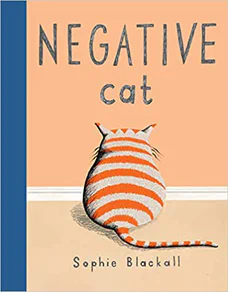Negative Cat

Recommended Age Range: Kindergarten through 3rd grade.
Publisher's Summary:
When a boy is FINALLY allowed to get a cat, he has no doubts about which one to bring home from the shelter. But Max the cat isn’t quite what the family expected. He shuns the toy mouse, couldn’t care less about the hand-knitted sweater, and spends most of his time facing the wall. One by one, the family gives up on Max, but the boy loves his negative cat so much, he’ll do anything to keep him. Even the thing he dreads most: practicing his reading. Which, as it turns out, makes everything positive!

Dr. Annie's Takeaways
Recommended for: This is a sweet, legitimately funny story about a grumpy rescue cat and a boy who doesn’t give up on him. It’s also a story about valuing the act of reading, no matter how one reads (slowly, quickly, out loud, etc.). The main character states that he has trouble with reading and that “words only make sense when I read them out loud slowly,” but no specific diagnoses are given, so this book could be a fun read for any child who is currently feeling challenged by reading. Lovers of grumpy cats and quirky rescue pets will particularly enjoy this book.
Tone: Funny, a bit irreverent, with a sweet ending
Story Quality: I laughed out loud multiple times when I first read this book, and then I sent the YouTube link to my husband and made him watch it because I thought it was so great. It’s a funny, loving book that features a boy who struggles with reading and his beloved rescue cat who doesn’t like the same things most cats do. It’s refreshing, and I can’t quite explain why I love it, but I do.
Illustrations: Somewhat vintage-looking illustrations (think Corduroy the Bear) with characters who have big eyes and slightly exaggerated expressions.
Representation: The main character is a boy with a White father, a mother with brown skin and curly black hair, and a sister with light brown skin and straight black hair. The boy has light brown skin and straight black hair. The boy does not have a specific diagnosis, but he states, “I’m not so great at reading! Words only make sense when I read them out loud slowly, and the kids at school stare and laugh at me.” The “lady from the [animal] shelter” is a woman with short purple hair. The boy’s classmates are diverse (i.e., have different genders and skin colors).
Psychological Practices: This book is about a boy with reading challenges, but it is even more about the power of loving and connecting with someone–in this case, a grumpy cat–exactly as they are. The dyslexia-relevant aspects include the boy’s parents’ requirement that if he gets a cat, he must take care of it and read for 20 minutes every day (“Ugh,” says the boy, “I’m not so great at reading!”), and the ending, in which the boy realizes that his “negative cat” who doesn’t enjoy toys or treats enjoys being read to. The story ends with the boy’s whole class visiting an animal shelter to read out loud to the cats–“fast or slow, however we like.” It’s a sweet way to de-emphasize how a child reads (quickly, slowly, out loud, silently) and to re-emphasize the value of reading at one’s own pace in whatever style works best. After all, the cats love being read to, no matter how!
Concerns: There is a line that states that kids at school stare and laugh at the boy when he is reading out loud. If a child has experienced this (which sadly many children have), it could be helpful for them to know they’re not alone. If a child has not experienced teasing due to their reading, this line could be unnecessarily stigmatizing.
